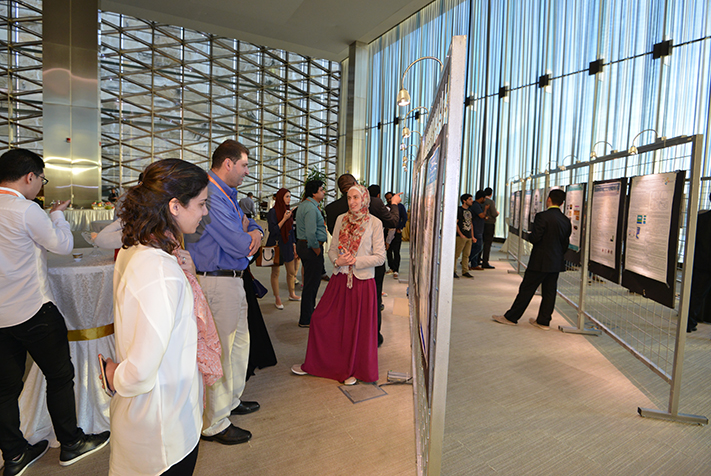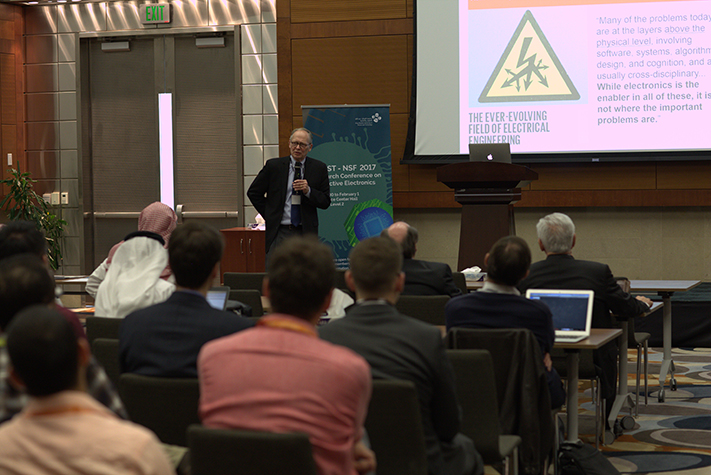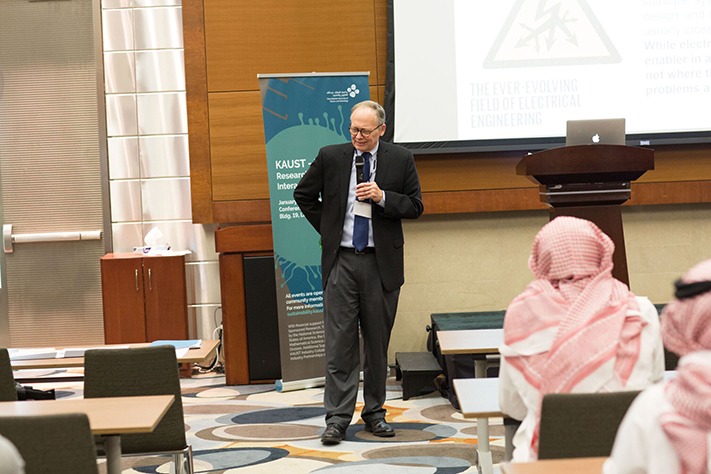The best and the brightest

The U.S. National Science Foundation (NSF) and KAUST jointly organized the KAUST-NSF Research Conference on Interactive Electronics held on the University’s campus from January 30 to February 1.
The conference was sponsored by the KAUST Office of Sponsored Research (OSR), the NSF, the KAUST Industry Collaboration Program (KICP) and the University’s Computer, Electrical and Mathematical Science and Engineering (CEMSE) Division.
Sharing research, building networks
Featuring three days of technical talks, presentations, networking sessions and a poster presentation session, the conference also included a Women in Science and Engineering (WISE) event to promote the greater participation of women in science and a Nex-gen in Science and Engineering (NISE) session with students from The KAUST School.
Research and industry leaders on campus

Attendees from around the world assembled on the University's campus for the KAUST-NSF Research Conference on Interactive Electronics held from January 30 to February 1. Photo by Pietro Orciuolo.
“The conference increasingly serves as the bridging point to display our research strength, the University’s beautiful campus and the rich culture and commitment of Saudi Arabia to science and technology. It also shatters many previous perceptions and allows our community to network extensively,” Hussain said.
Boon Ooi, KAUST professor of electrical engineering and the general chair of the 2017 conference, noted, “We were thrilled to host the KAUST-NSF conference, as it attracted many senior and junior academic, research and industry leaders from both in the Kingdom and internationally to speak and interact with our KAUST research community.
“Throughout the three days of the conference, we exchanged many new ideas, and I was particularly impressed to see a significantly high number of female high school students participating in the WISE session. I hope that some of them will be inspired to develop a successful science and engineering career in the future.”
After Moore’s law
Mark Lundstrom, distinguished professor of electrical and computer engineering at Purdue University and a U.S. National Academy of Engineering (NAE) member, discussed the “new electronics,” a term coined in 1960 by Frederick Terman, an American professor considered to be father of Silicon Valley, in his conference plenary talk.

Mark Lundstrom, distinguished professor of electrical and computer engineering at Purdue University, speaks to the KAUST audience during his plenary talk at the KAUST-NSF Research Conference on Interactive Electronics. Photo by Meres J. Weche.
“We are now seeing the end of device scaling and the end of Moore’s law,” he said. “Electronics will continue to advance and their impact on society will grow, but things are changing—this raises a lot of questions for us in electronics. Increasingly, progress will be driven by technology integration, system design and software. We need to ask ourselves if 21st century electronics will be about realizing the potential of Terman’s ‘new electronics,’ or whether there will be a ‘new, new electronics.’ We must discover a vision to propel electronics through the next 40 to 50 years.”
The ‘new, new electronics’

Mark Lundstrom, distinguished professor of electrical and computer engineering at Purdue University, talks to the KAUST audience during the KAUST-NSF Research Conference on Interactive Electronics. Photo by Meres J. Weche.
“Our ‘new, new electronics’ will be much broader than in the past and will touch a wide range of science,” he continued. “These will be done by teams who transcend disciplines, and they will be driven by problems, will reshape disciplines, create new ones and identify fundamental research questions. Problem-driven research will energize a new generation of researchers and will provide them with the experiences and education they need to become modern technology leaders. There is no roadmap to this new electronics, but the opportunity is there. Striving to make a difference in the real world is what we should all hope for.”

Grace Huili Xing, professor of electrical and computer engineering and materials science and engineering at Cornell University, gives a presentation about her research work at the KAUST-NSF Research Conference on Interactive Electronics. Photo by Meres J. Weche.
Grace Huili Xing, a professor of electrical and computer engineering and materials science and engineering at Cornell University, echoed Lundstrom’s remarks in her keynote talk.
“Moore’s law is coming to an end, and we must come up with new materials or devices or new applications,” she said. “To try to solve this problem, we have to ask ourselves if we can actually come up with these new devices, and we must look at multiple options to do this.”
In-Kingdom technology development
In his industry talk, Dr. Ghaithan Al-Muntasheri, chief technologist from EXPEC Advanced Research Center (EXPEC ARC) in Saudi Aramco, outlined EXPEC ARC’s investigation and development of advanced sensors to economically complete, control, monitor and sustain well production.

Dr. Ghaithan Al-Muntasheri, chief technologist from EXPEC Advanced Research Center (EXPEC ARC) in Saudi Aramco, gives a presentation during the KAUST-NSF Research Conference on Interactive Electronics held from January 30 to February 1 on the University's campus. Photo by Pietro Orciuolo.
“Oil and gas will continue to be the backbone of global energy supply, and natural gas will become even more important in decades to come,” he said. “The industry’s challenge is to employ the right technologies to ensure reliable production and sustainable supply. EXPEC ARC has been steered to create innovative and high-impact solutions in wide domains. When it comes to downhole monitoring applications, we deal with extremely harsh environments, and we need timely, accurate and reliable information about how our reservoirs are performing. For this, we need advanced technologies with new capabilities for sensing a wide range of parameters.”
“I see challenges as opportunities for all of you here,” he continued. “Challenges are opportunities for you to solve problems in your field. At Saudi Aramco, collaborations are very important to us, and to accomplish our R&D mission, we seek to engender the local research and technology ecosystem. We are now collaborating with KAUST research centers to develop new and cutting-edge upstream technologies. We cannot be a global enterprise unless we are a technology leader.”
An impressive event
Conference attendees and speakers were overwhelmingly positive about the event’s impact on research and collaborations.

Attendees from around the world assembled on the University's campus for the KAUST-NSF Research Conference on Interactive Electronics held from January 30 to February 1. Photo by Pietro Orciuolo.
“The KAUST-NSF conference was an extremely well-organized event that integrated cutting-edge research presentations, outreach activities with schoolchildren and candid discussions on women in science and engineering,” noted Xing. “The University has breathtaking views and infrastructure, but the most exciting part of my trip was meeting people with great aspirations at KAUST.”
“I see a lot of potential for the oil and gas industry to benefit from the University’s research, ideas and R&D programs, and I was impressed with the KAUST facilities and the recognition the University has received from the international R&D community. The number of attendees and the distances they had to travel to attend was an excellent indicator of how international researchers view KAUST,” Al-Muntasheri added.
“After hearing so much about KAUST, it was a real pleasure to visit and see for myself all the exciting work underway at the University,” said Lundstrom. “I was impressed with the facilities and programs, but most of all I was impressed by the students and faculty and their vision for a new era of materials and devices that address the challenges of the 21st century.”

